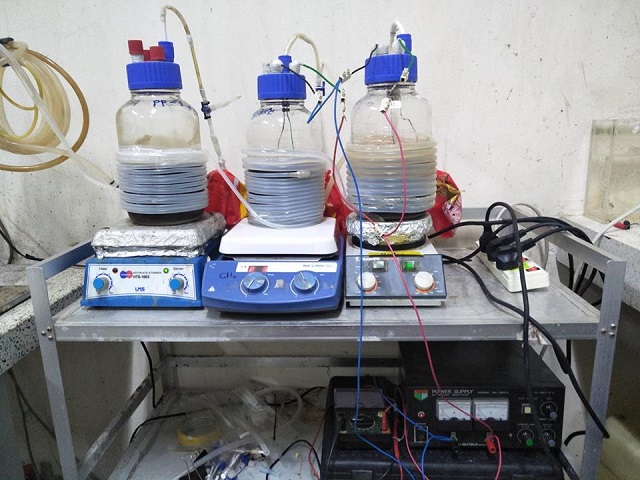Project Title: Bio-hydrogen and methane production from effluent of dark fermentation by microbial electrolysis cell
Researcher(s): Sulfan Baka, Rattana Jariyaboon, Sureewan Sittijunda, Prawit Kongjan,
Affiliation: Faculty of Environment and Resource Studies, Mahidol University

Research Details (In Brief): Hydrogen (H2) and methane (CH4) are attracting as renewable energies to reducing greenhouse gas emissions. Wastes glycerol (WG) and distillery wastewater (DW) are the most suitable sources of nitrogen and carbon for anaerobic microorganisms for H2 and methane production. The main purpose of this research was to utilize DW and WG to produce H2 by dark co-fermentation and to produce H2 and CH4 from effluent discharged from dark fermentation by using membrane less microbial electrolysis cells (MEC). By using DW:WG at a ratio 99-1 (% v/v) in batch dark co-fermentation, highest H2 production yield of 160.6 mLH2/g-VS was achieved. Followed by continuous H2 production using continuous stirred tank (CSTR) reactor fed by 99-1 (% v/v) DW:WG ratio at hydraulic retention time (HRT) 3 days, corresponding to organic loading rate (OLR) 19.1 g-Vs/d L could provide hydrogen yield of 117 mL-H2/g-VS. Effluent from H2 production in CSTR reactor was later used to produce H2 and CH4 in batch mode operation by using 2 membrane less MECs applied power supply at 1.0 volts and 10 Ohm and inoculated with anaerobic digested sludge. The first MEC (R-1) carried out without stirring could achieve rather low hydrogen yield of 13.5 mL-H2/g-Vs and methane yield of 84.0 ml-CH4/g-VS. While, the second MEC (R-2) carried out with stirring 120 rpm could produce hydrogen with a yield of 48.9 mL-H2/g-Vs and later generate methane with a yield of 75.0 mL-CH4/g-VS. The experimental results suggest that enhancing hydrogen and methane production could be achieved by coupling dark fermentation and microbial electrolysis cell.
Award Grant Related to the Project:
2nd runner-up award (oral presentation). The 8th Sci-tech symposium. April 11, 2018. Pre-clinical science building, Faculty of Science and technology, Prince of Songkla University, Pattani campus
Honorable mention (poster presentation). The 3rd biofuels and biochemical products production from agricultural biomass. June 17, 2019. Grand Pavilion, Rachawadee Resort and Hotel. Khon Kaen
Publishing: Sulfan Baka, Rattana Jariyaboon, Sureewan Sittijunda, Prawit Kongjan. Hydrogen and methane production from distillery wastewater and glycerol waste by coupling dark fermentation and microbial electrolysis cell. The 3rd Biomanufacturing Symposium 2019. April 9-10, 2019. Swiss Garden Beach Resort. Perak. Malaysia. (oral presentation)
Key Contact Person: Asst.Prof.Dr.Sureewan sittijunda, 062-1459145, This email address is being protected from spambots. You need JavaScript enabled to view it.
ชื่อโครงการวิจัย: การผลิตไฮโดรเจนและมีเทนจากน้ำทิ้งกระบวนการหมักไร้แสงด้วยเซลล์อิเล็กโทรไลซิสจุลชีพ
ชื่อผู้วิจัย: ซุลฟาน บากา รัตนา จริยบูรณ์ สุรีย์วัลย์ สิทธิจันดา ประวิทย์ คงจันทร์
ส่วนงาน: คณะสิ่งแวดล้อมและทรัพยากรศาสตร์ มหาวิทยาลัยมหิดล
รายละเอียดผลงานวิจัย (โดยย่อ): ไฮโดรเจนและมีเทนได้รับความสนใจในปัจจุบันที่ช่วยลดการปลดปล่อยแก๊สเรือนกระจก น้ำกากส่าและของเสียกลีเซอรอลเป็นของเสียที่มีแหล่งไนโตรเจนและคาร์บอนที่เหมาะสมต่อการเจริญเติบโตของจุลินทรีย์ไร้ออากาศสำหรับการผลิตไฮโดรเจนและมีเทน ในงานวิจัยนี้มีวัตถุประสงค์หลักเพื่อใช้ประโยชน์น้ำกากส่าและของเสียกลีเซอรอลเพื่อผลิตไฮโดรเจนจากการหมักร่วมแบบไร้แสงและผลิตไฮโดรเจนและมีเทนจากน้ำทิ้งกระบวนการหมักไฮโดรเจนโดยใช้เซลล์อิเล็กโทรไลซิสจุลชีพชนิดไร้เมมเบรน (MEC) จากการหมักย่อยร่วมแบบไร้แสงแบบแบทช์ระหว่างน้ำกากส่าและของเสียกลีเซอรอลที่อัตราส่วน 99-1 (% v/v) สามารถผลิตไฮโดรเจนได้สูงสุด 160.6 mLH2/g-VS การผลิตไฮโดรเจนแบบต่อเนื่องโดยใช้ถังปฏิกรณ์กวนต่อเนื่อง (CSTR) โดยป้อนน้ำกากส่าและของเสียกลีเซอรอลที่อัตราส่วน 99-1 (% v/v) ที่ระยะเวลากักเก็บ (HRT 3 วัน) ซึ่งเทียบเท่าอัตราบรรทุกสารอินทรีย์ (OLR) 19.1 g-Vs/d L สามารถผลิตไฮโดรเจนได้ 117.0 mLH2/g-VS น้ำหมักจากการผลิตไฮโดรเจนด้วยถังปฏิกรณ์ CSTR ได้ถูกมาผลิตไฮโดรเจนและมีเทนโดยใช้เซลล์ MEC ชนิดไร้เมมเบรน 2 ชุด โดยป้อนความต่างศักย์ไฟฟ้า 1.0 โวลต์ ที่ความต้านทาน 10 โอห์ม และถูกเริ่มต้นระบบกล้าเชื้อที่เป็นสลัดจ์จากระบบย่อนสลายไร้อากาศ เซลล์ MEC ชุดที่ 1 (R-1) ที่ได้ถูกดำเนินการโดยไม่มีการกวน สามารถให้ผลผลิตมีไฮโดรเจน 13.5 mL-H2/g-Vs และ ผลผลิตมีเทน 84.0 ml-CH4/g-VS ส่วนเซลล์ MEC ชุดที่ 2 (R-2) ที่ดำเนินการโดยมีการกวนสามารถผลิตไฮโดรเจนได้ 48.9 mLH2/g-Vs และผลิตมีเทนได้ประมาณ 75.0 mLCH4/g-Vs โดยในการศึกษาครั้งนี้สามารถแสดงให้เห็นว่าสามารถเพิ่มการผลิตไฮโดรเจนและมีเทนโดยการเชื่อมต่อการหมักไร้แสงและเซลล์เซลล์อิเล็กโทรไลซิสจุลชีพชนิดไร้เมมเบรน
รางวัลที่ได้รับ:
รางวัลรองชนะเลิศอันดับ 2 (oral presentation) 8th Sci-tech symposium. Pre-clinical science building, Faculty of Science and technology, Prince of Songkla University, Pattani campus (11 เมษายน 2561)
รางวัลชมเชยการนำเสนอแบบโปสเตอร์. การประชุมกลุ่มวิจัยการพัฒนากระบวนการผลิตเชื้อเพลิงชีวภาพและสารมูลค่าเพิ่มจากชีวมวลทางการเกษตร ครั้งที่ 3 ณ ห้องแกรนด์พาวิลเลี่ยน โรงแรมราชาวดี รีสอร์ท แอนด์ โฮเทล จังหวัดขอนแก่น (17 มิถุนายน 2562)
การเผยแพร่ผลงาน: นำเสนอผลงานในการประชุมวิชาการระดับนานาชาติ เรื่อง Hydrogen and methane production from distillery wastewater and glycerol waste by coupling dark fermentation and microbial electrolysis cell. The 3rd Biomanufacturing Symposium 2019. Swiss Garden Beach Resort, Perak, Malaysia. (9-10 April 2019)
การติดต่อ : ผศ.ดร.สุรีย์วัลย์ สิทธิจันดา 062145-9145 This email address is being protected from spambots. You need JavaScript enabled to view it.

